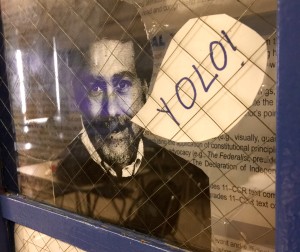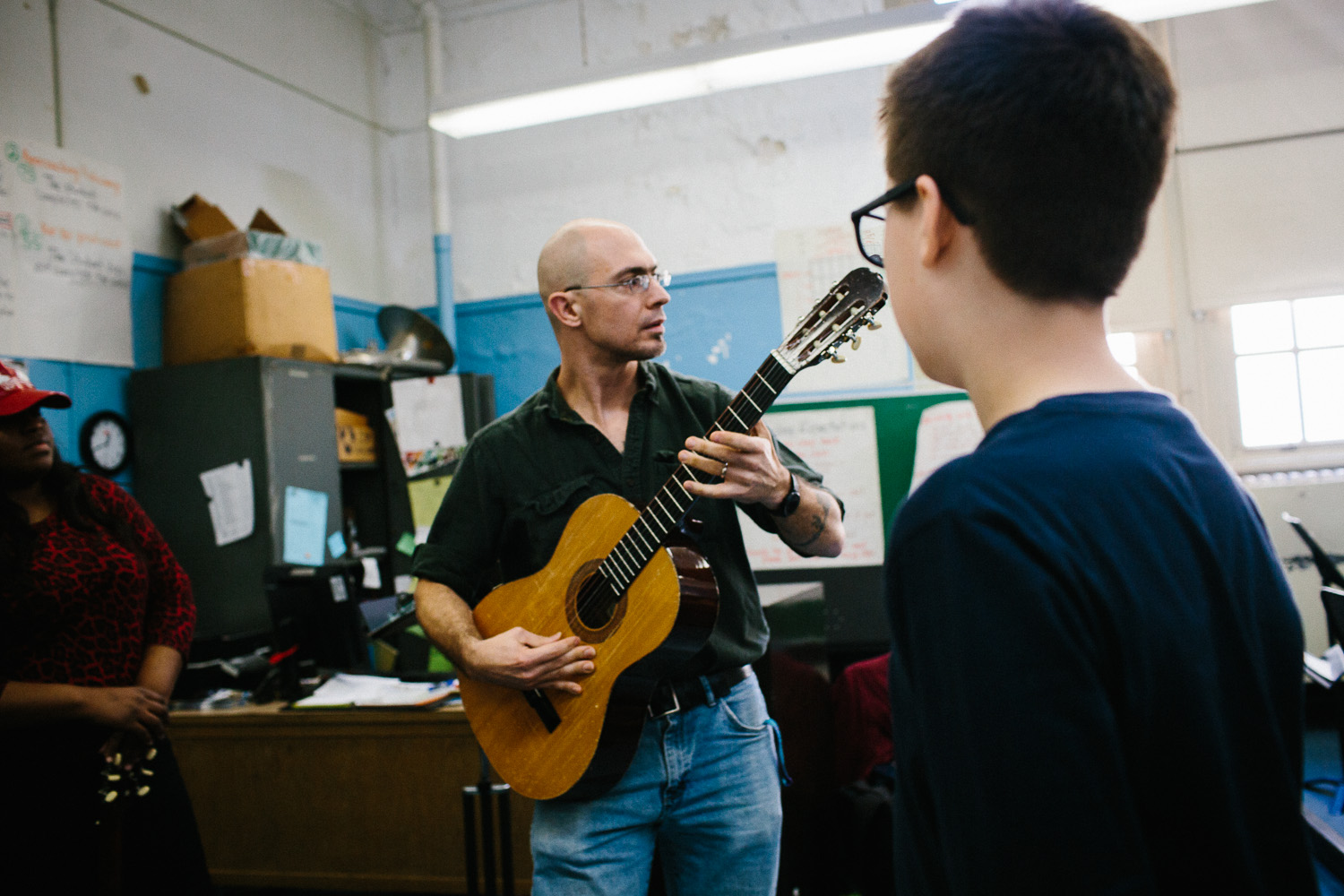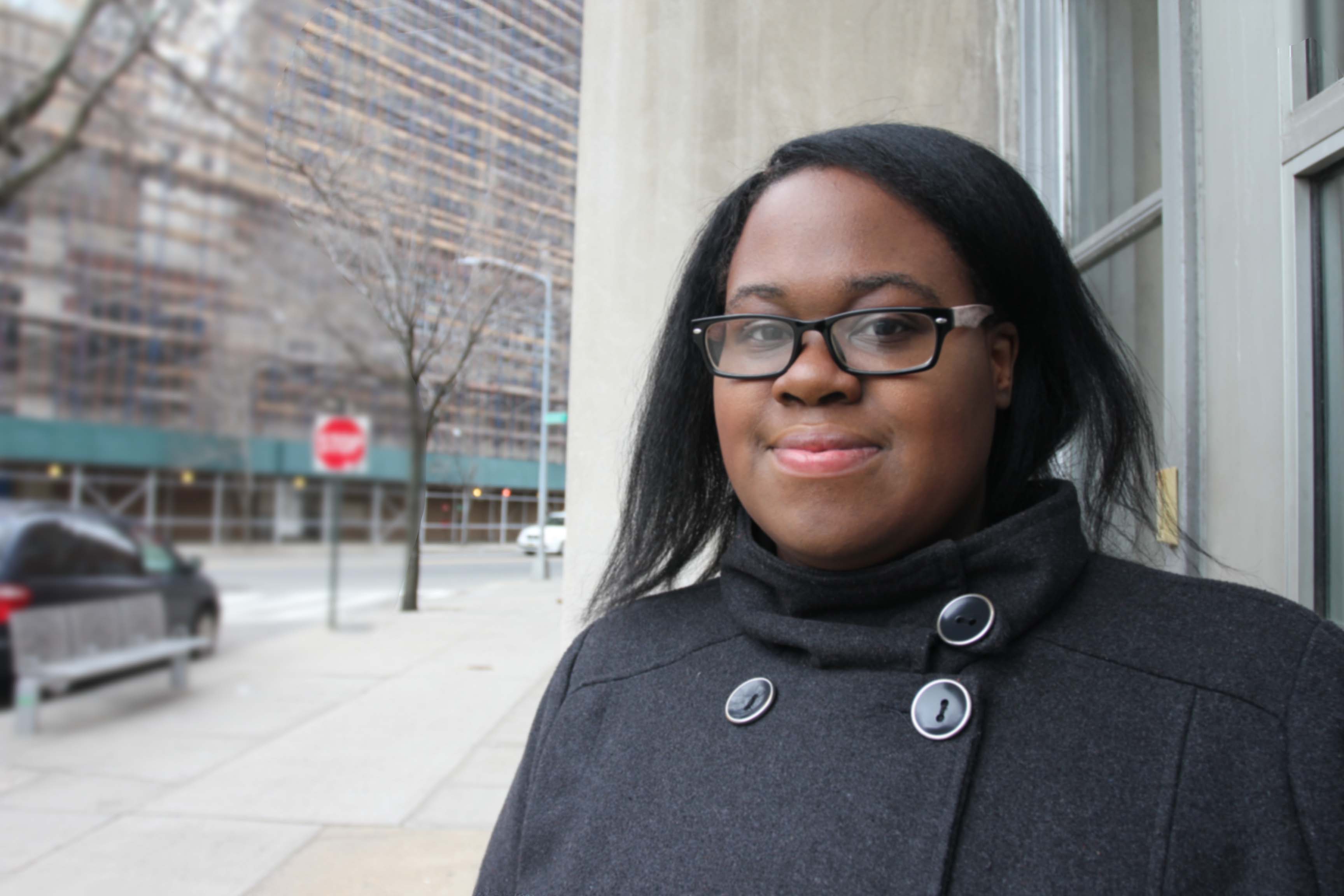
On a Monday morning in late February, Vincent Lumetta sat in his fourth-floor room at Flushing’s World Journalism Preparatory School. Cold light filtered in through half-drawn blinds. The windowpane to his right was caked with snow, and outside, cars crawled along a whitening Northern Boulevard.
From beyond Lumetta’s door, a microwave beeped. Wafts of warm cheese smells mixed with the chatter of teachers as they popped in their lunches.
“It’s usually 95 degrees in here,” Lumetta said of his frigid office. He rubbed his hands together and took a sip from his Fordham University mug. He has a dozen other mugs with college logos on the shelf, and a box of them on the floor. Lumetta’s collection represents years of college trips. His walls also bear the signs of his vocation: college pennants brighten the room, and posters of verdant campuses and stone buildings offer a landscape beyond the cold day outside the window.
Thick folders—drafts of college applications—sit in a pile on his desk. He hasn’t started on them yet.
Today, plumbers were working on a broken water pipe. Three classrooms had no heat, and Lumetta is worried about the students. “How are they supposed to learn like that?” he asked.
Whether the problem is related to classroom temperature or college admissions, Lumetta’s students are his priority. In an era of college-frenzied high schoolers, Lumetta steers his students toward the most fitting choices—and he keeps a calm head while doing it. But like most successful college counselors he also does much more than is required of him, essentially acting as a full-time personal adviser to scores of low-income students and their families. By Lumetta’s own estimate, he has guided 800 students through the college application process. He has been a college counselor at World Journalism Preparatory School for eight years, and a counselor (“we used to be called guidance counselors”) for over 30 years. In a city where private college counseling costs thousands of dollars, Lumetta does the job for standard pay at a public school. That’s a median salary of $53,600, according to the Labor Department.
Lumetta’s full title might as well be “Guidance Counselor Extraordinaire,” said Starr Sackstein, an English teacher at the school. Lumetta wears many hats, she said; he provides guidance and college counseling and leads the school’s safety team. He is also responsible for programming: what the school day looks like, the number of periods, what teachers teach, student placement. Sackstein has worked at other schools where several staff members divided up the work Lumetta handles alone.
After a change from a more lucrative career in finance, Lumetta has spent most of his adult life working in urban public schools. He came to World Journalism Preparatory School eight years ago from a public school on Staten Island. Since then, Lumetta has been helping his students get through high school, and into college.
“These days, you’re doomed without a college degree,” Lumetta said. He drives this point home with his students. Lumetta said his students apply to City University of New York schools by October 31st—even though the deadline is February. Why October?
“That’s my deadline,” he said, indulging a smile. Lumetta explaining the system is first-come, first-serve. He likes to make sure his students get in their applications in the fall.
At his current school, college is the expectation—not the exception, he said. Students begin taking PSATs (a wind-up exam to the SAT usually taken in 10th grade) in 9th grade, and the school emphasizes “prep, prep, prep.” But despite the increase in applications, Lumetta says, a recent trend has him worried. In the last few years, the number of seniors who don’t go on to college after World Journalism Preparatory School has crept up, from one student in 2012 to three in 2013, to five in 2014. This year, out of a class of 95 seniors, seven aren’t even considering applying to college. Lumetta says this increase is tied to a flagging economy, and the mistaken belief that higher education doesn’t guarantee students a job.
As he begins to describe this year’s college process, the walkie talkie on his desk blares. He turns down the volume. It’s just one of the many things that interrupt Lumetta.
In ten minutes, four students have come in to ask him questions: should they send in an extra recommendation letter, is it possible to switch into a higher-level math class this semester, and at what time do they leave for the college visit trip next week? A teacher comes in to ask his advice on Common Core test preparation. The phone has rung twice.
But Lumetta says he wouldn’t trade all this—the cold office, constant calls, and stacks of binders—for a highly paid job.
In a sentence: “he’s overworked and does way too much,” says Lumetta’s assistant, Connie Cressy, whose name is written in big red block letters on a sign attached to her desk. She says it with fondness. Cressy has been at the school as long as Lumetta has; she sits just a few feet from his door. Together, they’ve seen the number of college applications per student rise. It’s roughly fifteen schools per student now, she says.
That may be the average, but some seniors, like Amanda Guapisaca, have applied to twice that many schools. Several rooms away from Lumetta’s office, Guapisaca is sitting in a last-period study hall. In the middle of her spring semester, she is in the midst of receiving college letters. She applied to 27 schools—that’s many, especially for a girl who had her heart set on one.
“It’s a lot of paperwork,” Guapisaca says, grinning. She says all those applications meant extra work for Lumetta, “I gave him a run for his money.”
Unlike most seniors, Guapisaca came into Lumetta’s office in September with a very clear idea of what she wanted to do. She knew she wanted to become a veterinarian, and she knew which school she wanted to attend: Cornell.
“And he told me, no,” she laughs, “that’s not the only college you’re going to apply to.”
Guapisaca’s family had other considerations to worry about. Her brother, who is 13 months older than she, is in his freshman year of college now. When Guapisaca and her mother came in for their first college meeting with Lumetta, Guapisaca says, her mom told Lumetta, “I don’t know what to do.” Next year, Mrs. Guapisaca and her husband will bear the full load: they’ll be paying for both of their children’s tuition. Lumetta broadened Guapisaca’s outlook on colleges, helping her find veterinary programs at schools Guapisaca’s family could afford. He wrote one of her recommendation letters and guided her through applications.
But the applying to college was only half the battle. As acceptance letters carried good news for Guapisaca, financial aid packages brought complicated forms to decipher, numbers to untangle.
Hamilton College, a private school whose yearly tuition is over $55,000, awarded Guapisaca a board of director scholarship. Its total: $4,000. She laughs recalling Lumetta’s reaction, the rare flash of sarcasm. He told her she could do much better.
Lumetta did for Guapisaca what he does for all his students: he tried to find her a college that has the most to offer in her field of interest, but one that wouldn’t break the bank. It’s no easy feat. In the years since Lumetta started counseling, higher education has gotten more and more expensive; the costs of both four and two-year colleges have roughly doubled since 1982 to 2012, according to the National Center for Education Statistics. Tuition at a public, two-year college that used to cost just over $5,000 in 1982 now costs nearly $9,000. At a public, four-year college, that number has gone up from nearly $7,000 to $17,000. Private institutions can cost more than twice that amount.
Guapisaca appreciates his candor: “He’s straight up, that’s the thing,” she says.
Claudia Michalak, who is sitting across the table from Guapisaca in study hall, agrees. Michalak, also a college-bound senior, says she did not have as clear an idea of the school she wanted to attend as Guapisaca. Lumetta gave her facts about each school, and helped her figure out which ones were the best fit for her. Michalak says Lumetta often goes out of his way to help out students; when two of her classmates got rejected from their top schools, Lumetta called to petition the colleges. The students were accepted.
Guapisaca and Michalak both say Lumetta is the kind of guy who’s there for you if you come seeking help. And they agree on another thing: Lumetta loves his turtleneck sweaters. “He’s got one for every day of the week,” says Michalak. But as they’re about to describe Lumetta’s sartorial choices, the last bell of the day rings.
The girls gather their books and papers. Michalak runs out the door after another classmate. While she packs up, Guapisaca wonders about the road ahead.
“I have zero idea of where I’m going,” she says, in a voice that sounds far more excited than worried.
It’s early March, and Guapsica is still waiting to hear back from Cornell. It’s still her dream school, but she’s got at least a dozen other options. Not long ago, she was admitted to Hofstra University’s pre-veterinary program. And the acceptance letters keep rolling in.
Guapisaca may have zero idea of where she’s going to college, but that’s not necessarily a bad thing. As she talks about her options, her voice bubbles and her eyes open wide. Right now, she has many roads to choose between. In her second semester of senior year, Guapisaca is undecided and full of questions—and that’s exactly how Lumetta would want it to be.



